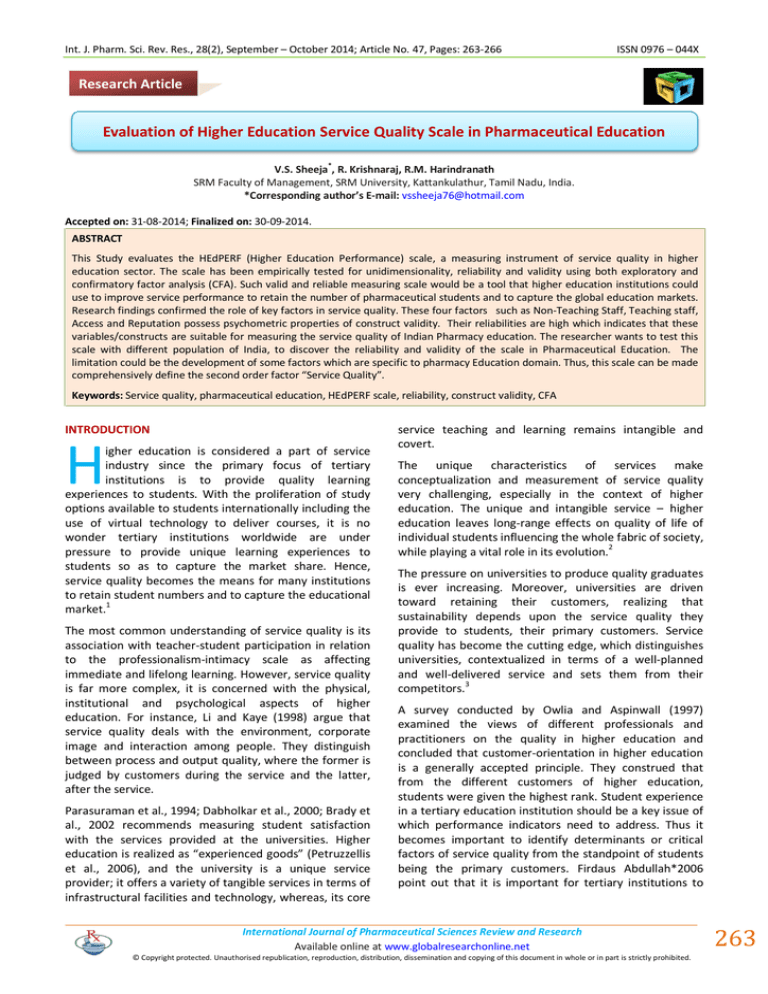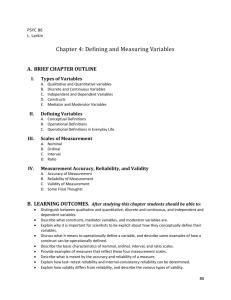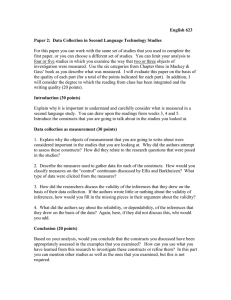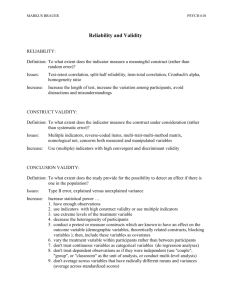
Int. J. Pharm. Sci. Rev. Res., 28(2), September – October 2014; Article No. 47, Pages: 263-266
ISSN 0976 – 044X
Research Article
Evaluation of Higher Education Service Quality Scale in Pharmaceutical Education
*
V.S. Sheeja , R. Krishnaraj, R.M. Harindranath
SRM Faculty of Management, SRM University, Kattankulathur, Tamil Nadu, India.
*Corresponding author’s E-mail: vssheeja76@hotmail.com
Accepted on: 31-08-2014; Finalized on: 30-09-2014.
ABSTRACT
This Study evaluates the HEdPERF (Higher Education Performance) scale, a measuring instrument of service quality in higher
education sector. The scale has been empirically tested for unidimensionality, reliability and validity using both exploratory and
confirmatory factor analysis (CFA). Such valid and reliable measuring scale would be a tool that higher education institutions could
use to improve service performance to retain the number of pharmaceutical students and to capture the global education markets.
Research findings confirmed the role of key factors in service quality. These four factors such as Non-Teaching Staff, Teaching staff,
Access and Reputation possess psychometric properties of construct validity. Their reliabilities are high which indicates that these
variables/constructs are suitable for measuring the service quality of Indian Pharmacy education. The researcher wants to test this
scale with different population of India, to discover the reliability and validity of the scale in Pharmaceutical Education. The
limitation could be the development of some factors which are specific to pharmacy Education domain. Thus, this scale can be made
comprehensively define the second order factor “Service Quality”.
Keywords: Service quality, pharmaceutical education, HEdPERF scale, reliability, construct validity, CFA
INTRODUCTION
H
igher education is considered a part of service
industry since the primary focus of tertiary
institutions is to provide quality learning
experiences to students. With the proliferation of study
options available to students internationally including the
use of virtual technology to deliver courses, it is no
wonder tertiary institutions worldwide are under
pressure to provide unique learning experiences to
students so as to capture the market share. Hence,
service quality becomes the means for many institutions
to retain student numbers and to capture the educational
1
market.
The most common understanding of service quality is its
association with teacher-student participation in relation
to the professionalism-intimacy scale as affecting
immediate and lifelong learning. However, service quality
is far more complex, it is concerned with the physical,
institutional and psychological aspects of higher
education. For instance, Li and Kaye (1998) argue that
service quality deals with the environment, corporate
image and interaction among people. They distinguish
between process and output quality, where the former is
judged by customers during the service and the latter,
after the service.
Parasuraman et al., 1994; Dabholkar et al., 2000; Brady et
al., 2002 recommends measuring student satisfaction
with the services provided at the universities. Higher
education is realized as “experienced goods” (Petruzzellis
et al., 2006), and the university is a unique service
provider; it offers a variety of tangible services in terms of
infrastructural facilities and technology, whereas, its core
service teaching and learning remains intangible and
covert.
The unique characteristics of services make
conceptualization and measurement of service quality
very challenging, especially in the context of higher
education. The unique and intangible service – higher
education leaves long-range effects on quality of life of
individual students influencing the whole fabric of society,
while playing a vital role in its evolution.2
The pressure on universities to produce quality graduates
is ever increasing. Moreover, universities are driven
toward retaining their customers, realizing that
sustainability depends upon the service quality they
provide to students, their primary customers. Service
quality has become the cutting edge, which distinguishes
universities, contextualized in terms of a well-planned
and well-delivered service and sets them from their
3
competitors.
A survey conducted by Owlia and Aspinwall (1997)
examined the views of different professionals and
practitioners on the quality in higher education and
concluded that customer-orientation in higher education
is a generally accepted principle. They construed that
from the different customers of higher education,
students were given the highest rank. Student experience
in a tertiary education institution should be a key issue of
which performance indicators need to address. Thus it
becomes important to identify determinants or critical
factors of service quality from the standpoint of students
being the primary customers. Firdaus Abdullah*2006
point out that it is important for tertiary institutions to
International Journal of Pharmaceutical Sciences Review and Research
Available online at www.globalresearchonline.net
© Copyright protected. Unauthorised republication, reproduction, distribution, dissemination and copying of this document in whole or in part is strictly prohibited.
263
© Copyright pro
Int. J. Pharm. Sci. Rev. Res., 28(2), September – October 2014; Article No. 47, Pages: 263-266
provide adequate service on all dimensions, and then
possibly to ascertain which dimensions may require
greater attention. For instance, quality improvement
programs should address not only the performance of
service delivery by the academics, but also the various
aspects surrounding the educational experience such as
physical facilities, and the multitude of support and
advisory services offered by the institutions.4,5
Helms and Key (1994) noted that students could be
classified as a raw material, customer, or even as
employees. As a raw material, students move through a
process and become the end product. As customers,
students purchase the service of education. Helms and
Key noted that students must be engaged in their studies,
must be motivated to perform, and are evaluated – them
much like employees.
In addition, quality of student performance is important
to a university in much the same way that quality of
employee performance is important in business setting.
Further analysing the differing roles of students, Helms
and Key (1994) pointed out that different educational
settings provide different roles for students. In large,
introductory classes the students are very much like
customers; however, in specialised graduate research
settings students are more like employees.6
According to Garvin (1988), service quality is a complex
and volatile issue, largely driven by contextual
unpredictability and complexity. Improving service quality
does not happen overnight; it requires a persistent
endurance to withstand the test of time through
collective mindsets and efforts. Success depends on the
dynamic exchange of mental models of both and nonacademic staff in achieving service quality. Although such
individual attributes as attitude and motivation may be
difficult to modify over a short period, given the right
stimulus through, for instance, an appropriate reward and
compensation system, mental models can be changed for
the benefit of the institution. One possibility would be to
institutionalize appropriate systems within educational
settings to facilitate a community of practice across all
levels. That is the way to go for higher education in a
7
changing world.
Mohammad S. Owlia et.al1996 suggests the first step in
satisfying customer needs is the determination of how
quality dimensions/factors are perceived by each group.
This information, together with the prioritized objectives
of a particular institution, will form the platform from
which a quality program can be developed.
MATERIALS AND METHODS
In terms of measurement methodologies, a review of
literature provides plenty of service quality evaluation
scales. A survey of the services marketing literature
reveals two main approaches to measure service quality:
SERVQUAL and SERVPERF (Cronin and Taylor, 1992). One
of the most popular methods, called SERVQUAL, has its
theoretical foundations in the gaps model and defines
ISSN 0976 – 044X
service quality in terms of the difference between
customer expectations and performance perceptions on a
number of 22 measures.8
The SERVQUAL instrument, “despite criticisms by a
variety of authors, still seems to be the most practical
model for the measurement of service quality available in
the literature” and thus expectations should be
considered when assessing service quality in Higher
Education (HE, here after). Regarding the stability of
expectations and perceptions of service quality over time,
in scope of HE, it was empirically concluded that student’s
perceptions of service experienced proved less stable
9,10
over time than expectations.
More recently, a new industry-scale, called HEdPERF was
developed comprising a set of 41 items. This instrument
aims at considering not only the academic components,
but also aspects of the total service environment as
experienced by the student. The author identified five
dimensions of the service quality concept such as Nonacademic, academic, aspects, reputation, program issues
and understanding. Items that are essential to enable
students to fulfill their study obligations, and relate to
duties carried out by non-academic staff. Through
questionnaire designed based on quality dimensions of
the introduced techniques, perceptions and expectations
among the stakeholders can be analysed.11
Sampling method
The sampling method used in the study is convenience
sampling. Data were collected from pharmacy students of
both public university and private university in Chennai,
for the period between October-December 2013. Data
had been collected using the “personal-contact”. The
questionnaires were administered with paper and pencil
approach among respondents.
Measures
Data were collected by using a questionnaire which is
composed of 41 items adopted from the original HEdPERF
(Firdaus, 2005), a scale uniquely developed to embrace
different aspects of public and private institution’s service
offering to the students. The questionnaire is tested with
a group of students to check the reliability, content
validity, as a part of pilot study. This scale is generated
and validated within higher education domain and along
with the results of the pilot study suggest that no scale
modification was required.
All the items in were presented as statements on the
questionnaire, with the same rating scale used
throughout, and measured on a 7-point, Likert-type scale
that varied from 1 for strongly disagree to 7 for strongly
agree. In addition to the main scale addressing individual
items, respondents were asked to provide an overall
rating of the service quality, satisfaction level.
There were also three open-ended questions allowing
respondents to give their personal views on how any
12
aspect of the service could be improved.
International Journal of Pharmaceutical Sciences Review and Research
Available online at www.globalresearchonline.net
© Copyright protected. Unauthorised republication, reproduction, distribution, dissemination and copying of this document in whole or in part is strictly prohibited.
264
© Copyright pro
Int. J. Pharm. Sci. Rev. Res., 28(2), September – October 2014; Article No. 47, Pages: 263-266
The draft questionnaire was eventually subjected to pilot
testing with a total of 50 students, and they were asked
to comment on any perceived ambiguities, omissions or
errors concerning the draft questionnaire. Data were
collected from students of both public universities and
private university in Chennai, for the period between
October –December 2013. Data had been collected using
the “personal-contact” approach.
ISSN 0976 – 044X
Tucker Lewis Index (TLI) and Root Mean square error of
Approximation (RMSEA). In accordance Bentler the model
fit is satisfactory where the GFIm, CFI and TLI exceeds 0.9
19
and RMSEA values are less than 0.08.
Table 1: Correlations, Descriptive Statistics & Cronbach
alpha.
Correlations
Construct
Mean
A total of 500 questionnaires were distributed to both
public and private university, of these 410 was returned
and ten discarded due to incomplete responses. The
number of usable sample size is 400.
No of
Items
Standard
Deviation
1
Non
Teaching
Staff
4
4.06
1.39
α=.86
Access
5
4.53
1.23
.558
**
α=.87
RESULTS AND DISCUSSION
Academic
Aspects
.524
**
.361
**
α=.86
.539
**
.467
**
.601
6
4.17
1.34
2
3
Measurement assessment
Reputation
There are missing data in the questionnaire and this is
imputed using Mean Imputation using SPSS 21. The
reliability of all the constructs are above .8 indicate good
reliability expect the one construct whose reliability is
77.13,14
**. Correlation is significant at the 0.01 level (2-tailed).
The exploratory factor analysis used to extract the items
for each construct by using principal component analysis
as it is commonly used method of parameter estimation.
The four constructs were extracted by using Varimax
rotation and this rotation is commonly used in Factor
analysis.
During the factor analysis, 23 items were deleted due to
cross loadings of items and low communality values (less
than 0.5) to more than one factor and poor factor
loadings of the items. The remaining items are statistically
significant as the t-values are in the range of 9.48 to
11.81, which are high.
From the methodology laid by a measurement model was
specified using Amos 21 by confirmatory Factor Analysis.
The measurement model will determine the convergent
and discriminant validity of the constructs and this will
assess the psychometric properties of the constructs.
Very recently, (Aguinis & Edwards, 2014) advises to use
confirmatory factor analysis (CFA) to evaluate the
construct validity.15,16
Multivariate normality was evaluated using Mardia’s
coefficient and the data was found to be non-normal as
the multivariate kurtosis (critical ratio) was 29, which
was much above ±2 and suggest, moderate multivariate
non-normality. Owing to the non-normal data, we use
Bollen-Stine bootstrapping method using 5000 samples
for parameter estimation as bootstrapping distribution
does not have rigorous assumptions like normal
distribution.17,18
Measurement model
The measurement model was analyzed using Amos 21
software with Maximum Likelihood Estimation. The fit
indices values used to assess the CFA model are Cmin/df,
Goodness of fit index (GFI), Comparative fit index (CFI),
3
4.26
1.43
4
**
α=.77
Table 2: Factors validity using CFA
Parameters
Value
Desirable Values
Cmin/df (degrees of freedom)
2.075
<3
2
Goodness of Fit (GFI)
0.912
> 0.9
3
IFI (Incremental fit Index)
0.953
> 0.9
4
CFI (Confirmatory fit index)
0.952
> 0.9
5
TLI (Tucker Lewis index)
0.953
> 0.9
6
Root Mean Square Error of
Approximation (RMSEA)
0.60
< 0.7
1
Construct validity
The two important validity are convergent and
discriminant validity. To measure the convergent validity,
Average variance extracted (AVE) calculated must be
above 0.5 and the path coefficient must be above 0.6. The
AVE for all the constructs are above 0.5 and the construct
reliabilities are above 0.7 suggest the convergent validity.
The squared inter construct correlation value of all the
constructs are lower than the AVE values indicate the
discriminant validity. The correlations between constructs
are significant shows nomological validity. Thus the
constructs used in the study possess convergent,
Discriminant & nomological validity.
Table 3: Average Variance Extracted (AVE), Construct
Reliability & Squared Correlation.
squared Inter
construct correlation
Constructs
AVE
Construct
Reliability
2
3
4
1. Non Teaching Aspects
0.6
0.86
0.34
0.36
0.33
2. Teaching Aspects
0.6
0.80
0.29
0.50
3. Access
0.6
0.87
4. Reputation
0.5
0.84
0.17
AVE is Average Variance extracted
We have analyzed to estimate the impact of common
method variance as this data collected is self reporting.
International Journal of Pharmaceutical Sciences Review and Research
Available online at www.globalresearchonline.net
© Copyright protected. Unauthorised republication, reproduction, distribution, dissemination and copying of this document in whole or in part is strictly prohibited.
265
© Copyright pro
Int. J. Pharm. Sci. Rev. Res., 28(2), September – October 2014; Article No. 47, Pages: 263-266
Using the Harman’s single Factor test, the variance
extracted by a single factor is 33% which is less than 50%,
indicates that there is no problem due to common
method bias. In order to confirm further, we did a latent
common factor method and found that the factor loading
do not change much with and without the common
factor.20
CONCLUSION
The results indicate that there are four factors which
serve as factors for service quality. These four factors are
Non-Teaching aspects; Teaching Aspects, Access and
Reputation possess psychometric properties of construct
validity. There reliabilities are high which indicates that
these variables/constructs are suitable for measuring the
service quality of Indian Pharmacy education. The
researcher wants to test this scale to other sample in
different population, to discover the reliability and
validity of the scale. Meanwhile some factors can be
developed which are Domain specific with respect to
Pharmaceutical Education. Thus, this scale can be made
comprehensively define the second order factor “Service
Quality”. The future research could be adding certain
variables thus performing a partial scale development
process.
REFERENCES
1.
2.
3.
4.
5.
6.
Yeo RK, Brewing service quality in higher education:
characteristics of ingredients that make up the recipe,
Quality Assurance in Education, 16 No 3, 2008, 266-286.
Parasuraman A, Zeithaml VA, Berry LL, Reassessment of
expectations as a comparison standard in measuring
service quality: implications for future research, Journal of
Marketing, 58, 1994, 111–124.
Kanji GK, Tambi AMA, Wallace W, A comparative study of
quality practice in higher education institutions in the US
and Malaysia, Total Quality Management, 10 No. 3, 1999,
357-371.
Owlia MS, & Aspinwall EM, TQM in higher education—a
review, International Journal of Quality & Reliability
Management, 145, 1997, 527–543.
Abullah Firadulla, Measuring service quality in higher
education: Three instruments compared. International
Journal of Research and method in education 26 No 1,
2006, 71-89.
Helms SK, Key H, Are students more than the customers in
the class room? Quality progress, 27, 1994, 97-99.
ISSN 0976 – 044X
7.
Garvin DA, Managing Quality, The Free Press, New York,
NY. 1988.
8.
Cronin JJ, Taylor SA, Measuring service quality:
reexamination and extension. Journal of Marketing, 56,
1992, 55–68
9.
Parasuraman A, Zeithaml VA, Berry LL, SERVQUAL: a
multiple-item scale for measuring consumer perceptions of
service quality, Journal of Retailing, 6 No 41, 1988, 12-40.
10. Hill FM, Managing service quality in higher education: the
role of student as primary consumer. Quality Assurance in
Education, 3, 1995, 10–21.
11. Abdullah F, Measuring service quality in higher education:
HEdPERF versus SERVPERF. Marketing Intelligence &
Planning, 24 No1, 2006a, 31–47.
12. Abdullah F, Measuring service quality in higher education:
three instruments compared. International Journal of
Research & Method in Education, 291, 2006b, 71–89
13. Hair, Joseph F, Tatham, Ronald L, Anderson, Rolph E, &
Black, William. Multivariate data analysis: Pearson Prentice
Hall Upper Saddle River, NJ 6, 2006
14. Nunnally, Jum C, Bernstein, Ira H, & Berge, Jos MF ten..
Psychometric theory McGraw-Hill New York. 226, 1967
15. Anderson, James C, & Gerbing, David W, Structural
equation modeling in practice: A review and recommended
two-step approach. Psychological bulletin, 103, No 3, 1988,
411.
16. Aguinis, Herman, & Edwards, Jeffrey R. Methodological
wishes for the next decade and how to make wishes come
true. Journal of Management Studies, 51, No 1, 2014, 143174.
17. Singh, Ramendra, & Das, Gopal. The Impact of Job
Satisfaction, Adaptive Selling Behaviors, and Customer
Orientation, on Salesperson’s Performance: Exploring the
Moderating Role of Selling Experience. Journal of Business
& Industrial Marketing, 28, No 7, 2013, 3-3.
18. Byrne, Barbara M. Structural equation modeling with
AMOS: Basic concepts, applications, and programming:
Routledge. 2013
19. Bentler, Peter M. On the fit of models to covariances and
methodology to the<em> Bulletin.</em>. Psychological
bulletin, 112, No 3, 1992, 400.
20. Podsakoff, Philip M, MacKenzie, Scott B, Lee, Jeong-Yeon, &
Podsakoff, Nathan P. Common method biases in behavioral
research: a critical review of the literature and
recommended remedies. Journal of applied psychology, 88
No 5, 2003, 879.
Source of Support: Nil, Conflict of Interest: None.
International Journal of Pharmaceutical Sciences Review and Research
Available online at www.globalresearchonline.net
© Copyright protected. Unauthorised republication, reproduction, distribution, dissemination and copying of this document in whole or in part is strictly prohibited.
266
© Copyright pro





